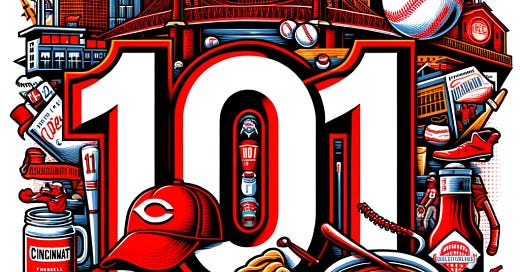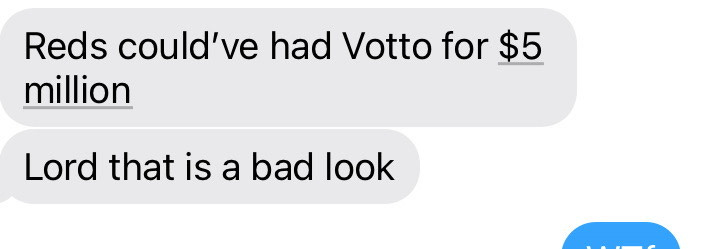Yesterday, I was in the waiting room of the local sawbones, slowly flipping through the pages of an eleven-year-old copy of Newsweek* when I received a text from a Braves fan, of all things. It was sent to one of several group messages where we talk about sports and various other nonsensical things.
*This isn’t true at all. To my eternal shame, I was scrolling through Twitter. I didn’t want to admit that to you, dear reader. It’s even more embarrassing than having a friend who is a Braves fan.
Here’s the message:
The Reds fans in that thread — Votto fans, all of us — were shocked and appalled. We are fans of Votto, after all, and would love to see the legendary first baseman finish his career in Cincinnati. Another reason for me to get irritated with Reds ownership! Huzzah!
Well, it took just a couple of minutes to discover that the news he had purportedly seen was that Joey Gallo had signed a one-year, $5 million contract with the Washington Nationals. Gallo is a completely different baseball player, as it turns out, one who has never played for the Redlegs. His response displayed a complete lack of shame: “I thought it was Votto? Did I read that wrong?” And then: “entirely possible I just assumed the Reds did something dumb.”
Not funny. Not funny at all.
Anyway, I don’t have any profound thoughts here. For all the deleterious effects that these phones have had on society, I have to say that I’m pretty happy to constantly have a handful of different groups where we text about sports and movies and memes and Tombstone gifs, plus plenty of other dumb stuff. All day long.
It’s been a while since I updated my ranking of the top 101 players in Reds history. You can read the full description of the project here, but the top fifty will get full essays about their lives and careers. Here’s where we are to this point:
Okay, let’s keep counting ‘em down!
#89: Norm Charlton. I already wrote about him!
#88: Fred Toney. Got the win in the only double no-hitter in baseball history. Four good seasons for the Reds from 1915 to 1918, going 61-49 with a deadball-assisted 2.18 ERA.
#87: Jeff Brantley. Cowboy has turned into a pretty darn good radio broadcaster, and the kids today are liable to forget that he was a fine closer during his time, as well. Tied with Rob Dibble and Tom Hume for seventh on the Reds all-time saves list, Brantley had a 2.64 ERA over four seasons in Cincinnati, leading the NL with 44 saves in 1996.
#86: Leo Cárdenas. Four time All-Star and the Gold Glove winning shortstop in 1965, Cárdenas was inducted into the Reds Hall of Fame in 1981.
#85: Babe Herman. Floyd Caves Herman only played three seasons for the Reds (1932, 1935-36), but he was pretty great during those seasons: .315/.379/.510. His best years came with Brooklyn.
#84: Johnny Temple. Solid second baseman and leadoff hitter who made four All-Star teams for the Reds (though two of them came in 1959 during that weird span when they were playing two ASGs each summer). Formed a great double play combo with Roy McMillan.
#83: César Gerónimo. The least-heralded member of The Great Eight, Geronimo was a fine defensive center fielder who won four Gold Gloves in a row during the peak Big Red Machine seasons. Plus, when I was a kid, I thought his name was really cool.
#82: Raisel Iglesias. Sixth on the Reds all-time saves list, he was way better than you think he was. I’m still salty over the fact that the penny-pinching Reds essentially gave Iglesias away for free.
#81: Wally Post. Averaged 31 home runs and 98 runs batted per season over his first eight years with the Reds. That’s pretty good!
#80: Gus Bell. Arrived in Cincinnati in a trade with Pittsburgh before the 1953 season; the 24-year-old Bell proceeded to hit .300/.354/.525 with 30 homers and 105 RBI, making the first of his four All-Star teams. He’s a Reds Hall of Famer, but his legacy extended long after his career into the present day. His son is former Reds 3B Buddy Bell, and his grandson is the club’s current manager.
#79: Jeff Shaw. Remember when the 1998 Reds had the fourth-lowest payroll in baseball, traded their scheduled Opening Day starter (Dave Burba) just before the season began, and then traded their only All-Star, Jeff Shaw, just before the All-Star Game? Wild times.
#78: Clay Carroll. The Hawk. Eight solid seasons for the Reds through 1975, 71-43 with a 2.73 ERA, with two All-Star appearances. Led the NL with 37 saves in the World Series season of 1972.
#77: Billy Werber. The heart and soul of the champion 1939 and 1940 Reds. Someone needs to write the definitive history of those clubs. They were fascinating, and under-remembered among Reds fans.
#76: Pete Donohue. Really great talk show host in the 1980s who somehow also won 20 or more games three times for the Reds in the 1920s.
#75: Hal Morris. Remember the way Morris would shuffle his feet all around the batter’s box as he awaited a pitch? I still think that was pretty great.
#74: Aaron Harang. Literally one of the ten best Reds pitchers of the last 75 years. Had the misfortune to play on some pretty bad clubs, unfortunately.
#73: Dan Driessen. Had a fine Reds career, but he will never be forgiven by a certain segment of fans who were upset that he wasn’t Tony Perez.
#72: Roy McMillan. The first Red to be featured alone on a Sports Illustrated cover (September 9, 1957). Bet you didn’t know that!
#71: Curt Walker. I wrote about him last year when I talked players who had been snubbed by the Reds Hall of Fame. Barely remembered today, Walker was a star left-handed hitting outfielder in the mid- to late-1920s for the Reds. He was remarkably consistent over his seven years in Cincinnati, hitting .303/.378/.441; his 18.8 wins above replacement is the second-highest among hitters who haven’t yet been elected to the Reds HOF. Walker’s .378 on-base percentage is seventh-best in franchise history, and higher than Barry Larkin, Eric Davis, and both Griffeys.
#70: Kal Daniels. I still can’t believe Kalvoski didn’t turn into a star. I thought he was a sure thing.
#69: Tom Browning. TB. My man TB.
#68: Dave Parker. In the mid-eighties, I was absolutely certain that Dave Parker was the coolest dude ever to walk the planet. I still believe that’s true.
#67: Mike Mitchell. You’ve never heard of him but he had a good six-year run with the Reds from 1907 to 1912. Bill James claims Mitchell had the best outfield arm of his era. Once played for a minor league team named the Schenectady Electricians which is pretty great, to be honest.
#66: Joe Nuxhall. The ol’ lefthander. Not quite a top fifty player in Reds history, but still one of the all-timers thanks to his time in the booth. A pretty good pitcher, though!
#65: Bob Purkey. Inducted into the Reds HOF in 1974, Purkey was a five-time All-Star (though, again, four of those came in seasons where they had two ASGs and he made the roster each time). A member of the pennant-winning 1961 club, Purkey joined Jim O'Toole and Joey Jay to form Cincinnati’s “Big Three” in the rotation. His best season was 1962 when he went 23-5 with a 2.81 ERA.
#64: Don Gullett. How many pitchers looked like Hall of Famers early in their careers, only to break down from injury later? Asking for a friend (named Gary Nolan).
#63: Red Lucas. Nicknamed “The Nashville Narcissus.” That’s a no-doubt, inner-circle Hall of Fame moniker.
#62: Jake Beckley. His nickname was “Eagle Eye,” but I have some questions about that after looking at his photo. A baseball Hall of Famer from the turn of the century who was finally inducted into the Reds Hall of Fame a decade ago.
#61: Bob Ewing. He shot J.R.
#60: Sonny Gray. Probably had the most underrated Reds career of any pitcher in my lifetime: 3.49 ERA, 135 ERA+, 10.1 bWAR over three seasons in Cincinnati.
#59: John Reilly. “Long John” is not a particularly clever nickname. Played ten seasons for the Reds in the 1880s and 90s, in both the National League and the American Association. Led the league twice in homers (including a career-high 13 in 1888 to go along with 103 RBI) and triples once (26 in 1890).
#58: Ken Raffensberger. Lefty hurler who has a decent case for the Reds HOF, Raffensberger pitched eight seasons for the Reds in the 1940s and 50s. Posted 26 bWAR over that span.
#57: Sam Crawford. Called “Wahoo Sam” because he hailed from Wahoo, Nebraska, Crawford was the best interview from The Glory of Their Times (one of the best baseball books ever written; the audiobook version is gold, Jerry, gold). When author Lawrence Ritter asked him how he wanted to be remembered, Crawford said: “When I kick off they'll say, ‘Well, good old Sam, he wasn't such a bad guy after all. Everything considered, he was pretty fair and square. We'll miss him.’”
#56: Bubbles Hargrave. Why aren’t any players nicknamed “Bubbles” these days?
#55: Rob Dibble. I mention Chapman below, but Dibble was the first flame-throwing reliever who got crowds on their feet when he entered a game. The best of the Nasty Boys.
#54: Ed Bailey. Not this Ed Bailey.
#53: Billy Rhines. Highest-rated player on this list that you haven’t heard of? Perhaps!
#52: John Franco. Most baseball fans will remember him as a New York Metropolitan, but he was a great reliever during his six seasons in Cincinnati. Third all-time in club history in saves, behind only Danny Graves and Francisco Cordero. A three-time All-Star.
#51: Aroldis Chapman. Just two saves behind Franco on the franchise list, Chapman narrowly edges out his fellow lefty closer. Four All-Star selections in six seasons, and each of his appearances for the first couple of seasons were simply can’t miss. If you weren’t at GABP to see Chapman enter a close game in the ninth inning in his first season or two, you don’t know what you missed. It was electric.
Next, we will begin counting down the top fifty. Or The Big 50, if you prefer. In the meantime, let the debate begin: Where will Ryan Lavarnway end up on the list?







I didn’t see Lisalverto Bonilla 51-100, I can only assume he is top 10.
If Lavarnway isn't top 5, we riot.